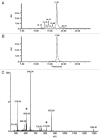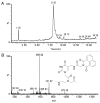PNA bearing 5-azidomethyluracil: a novel approach for solid and solution phase modification
- PMID: 22772040
- PMCID: PMC3429531
- DOI: 10.4161/adna.20158
PNA bearing 5-azidomethyluracil: a novel approach for solid and solution phase modification
Abstract
Fmoc- and Boc-protected modified monomers bearing 5-azidomethyluracil nucleobase were synthesized. Four different solid-phase synthetic strategies were tested in order to evaluate the application of this series of monomers for the solid-phase synthesis of modified PNA. The azide was used as masked amine for the introduction of amide-linked functional groups, allowing the production of a library of compounds starting from a single modified monomer. The azide function was also exploited as reactive group for the modification of PNA in solution via azide-alkyne click cycloaddition.
Figures






Similar articles
-
A solid-phase CuAAC strategy for the synthesis of PNA containing nucleobase surrogates.Artif DNA PNA XNA. 2013 Jan-Mar;4(1):4-10. doi: 10.4161/adna.23982. Epub 2013 Jan 1. Artif DNA PNA XNA. 2013. PMID: 23422048 Free PMC article.
-
PNA Molecular Beacons Assembled by Post-Synthetic Click Chemistry Functionalization.Chembiochem. 2015 Oct 12;16(15):2156-61. doi: 10.1002/cbic.201500248. Epub 2015 Sep 3. Chembiochem. 2015. PMID: 26227668
-
Synthesis and oligomerization of Fmoc/Boc-protected PNA monomers of 2,6-diaminopurine, 2-aminopurine and thymine.Org Biomol Chem. 2012 Jan 28;10(4):876-81. doi: 10.1039/c1ob06582c. Epub 2011 Dec 12. Org Biomol Chem. 2012. PMID: 22159214
-
Click chemistry with DNA.Chem Soc Rev. 2010 Apr;39(4):1388-405. doi: 10.1039/b901971p. Epub 2010 Feb 9. Chem Soc Rev. 2010. PMID: 20309492 Review.
-
Azide-Modified Nucleosides as Versatile Tools for Bioorthogonal Labeling and Functionalization.Chem Rec. 2022 May;22(5):e202100322. doi: 10.1002/tcr.202100322. Epub 2022 Feb 21. Chem Rec. 2022. PMID: 35189013 Review.
Cited by
-
A solid-phase CuAAC strategy for the synthesis of PNA containing nucleobase surrogates.Artif DNA PNA XNA. 2013 Jan-Mar;4(1):4-10. doi: 10.4161/adna.23982. Epub 2013 Jan 1. Artif DNA PNA XNA. 2013. PMID: 23422048 Free PMC article.
-
Clickable PNA Probes for Imaging Human Telomeres and Poly(A) RNAs.ACS Omega. 2018 Nov 30;3(11):15343-15352. doi: 10.1021/acsomega.8b02550. Epub 2018 Nov 12. ACS Omega. 2018. PMID: 30556003 Free PMC article.
-
Fluorogenic PNA probes.Beilstein J Org Chem. 2018 Jan 29;14:253-281. doi: 10.3762/bjoc.14.17. eCollection 2018. Beilstein J Org Chem. 2018. PMID: 29507634 Free PMC article. Review.
-
Pyrene-modified PNAs: Stacking interactions and selective excimer emission in PNA2DNA triplexes.Beilstein J Org Chem. 2014 Jul 2;10:1495-503. doi: 10.3762/bjoc.10.154. eCollection 2014. Beilstein J Org Chem. 2014. PMID: 25161706 Free PMC article.
-
Synthesis and Improved Cross-Linking Properties of C5-Modified Furan Bearing PNAs.Molecules. 2017 Nov 20;22(11):2010. doi: 10.3390/molecules22112010. Molecules. 2017. PMID: 29156637 Free PMC article.
References
-
- Nielsen PE, Egholm M. Peptide Nucleic Acids: Protocols and Applications. 2. Wymondham: Horizon Press, 2004.
-
- Nielsen PE. Gene targeting using peptide nucleic acid. Methods Mol Biol. 2005;288:343–58. - PubMed
Publication types
MeSH terms
Substances
LinkOut - more resources
Full Text Sources
